A paddle dryer takes water out of materials that are hard to dry. It uses heat that does not touch the material and keeps moving it around. Many companies use this dryer to make products safely and quickly. People in food, chemical, medicine, and sludge treatment use it a lot.
Paddle dryers work at low heat and often use a vacuum. This helps keep the material safe and dries it evenly.
The clean design and vacuum help keep the product good and stop germs from getting in.
The paddle dryer market was worth about $1.2 billion in 2023. It is still getting bigger, which shows it is important in factories today.
Key Takeaways
Paddle dryers use indirect heat and mixing paddles. They dry sticky or sensitive materials evenly and safely. They save energy by closely controlling temperature. They also reuse heat. This makes drying faster and cheaper. These dryers work well in many industries. Some examples are food, medicine, chemicals, and waste treatment. Vacuum and sealed designs protect products from contamination. They keep drying gentle for delicate materials. Customizable features and smart controls help companies adjust drying. This lets them fit different materials and needs.
What Should You Know About Paddle Dryers?
Paddle dryers are industrial machines used for efficient drying and mixing of materials. They operate by using rotating paddles to move and heat the material simultaneously, ensuring uniform drying.
What Is a Paddle Dryer
A paddle dryer is a machine used in factories to take water out of things that are hard to dry. It has a long, flat container with a spinning shaft in the middle. The shaft holds special paddles shaped like wedges. These paddles turn and move the material around. Hot steam, water, or oil flows inside the paddles. This gives heat to the material without touching it. The heat goes through the paddles to dry the material. This design lets people control the temperature very well. It also mixes everything so sticky things do not stick together.
Note: Paddle dryers have a lot of space for heat in a small area. The paddles keep things moving so they do not clump. This helps everything dry the same way.
The main parts of a paddle dryer are:
Component | Description |
|---|---|
Trough or Vessel | The main part that can handle high heat and pressure. |
Paddle Shaft | The middle shaft with paddles that spin and move the material. |
Paddles | Hollow blades that stir the material and help heat move through. |
Heating/Cooling Medium | Steam, hot water, or oil that heats or cools the dryer. |
Drive System | Motors and gears that make the shaft and paddles turn. |
Discharge Mechanism | Valves or screws that take out the dried material. |
Key Features
Paddle dryers are different from other dryers because of their special design and smart features. Some important things about them are:
The paddles are hollow and shaped like wedges to give more heat.
The heating medium inside the paddles saves energy.
The paddles mix the material so it dries evenly and does not clump.
Some dryers can collect extra liquids to save money and help the environment.
Paddle dryers mix and heat in one machine, unlike other dryers.
Many new paddle dryers have smart controls with sensors and computers. These help watch the process, fix problems early, and control everything better.
You can change the design to fit what each company needs, especially for food and medicine.
💡 Tip: New paddle dryers use less energy and can reuse heat. This helps save power and is better for the planet.
Applications
Paddle dryers are used in many jobs and can dry many kinds of materials. They are good for things that are sticky, thick, or break down easily. People use them for:
Chemical industry: Drying chemicals, resins, and other products.
Pharmaceutical industry: Drying medicine parts that cannot get too hot.
Food industry: Drying food, fish meal, and kitchen waste.
Environmental and waste management: Drying sludge from water plants, coal sludge, and gypsum.
Fertilizer and agriculture: Drying fertilizer, wine waste, and other plant materials.
Paddle dryers can do many jobs in one machine. They can mix, add liquids, make things thicker, react, dry, and cool. Many work with a vacuum to protect sensitive things and make better products. These dryers are good for big factories. They keep dust inside, dry a lot at once, and are easy to clean.
Paddle dryers help companies get good results every time they dry something. Their smart design and many uses make them a great choice for drying today.
How paddle dryer Works
Paddle dryers operate by using rotating paddles within a horizontal cylinder to mix and heat materials, effectively removing moisture. The paddles create uniform heat transfer, ensuring consistent drying.
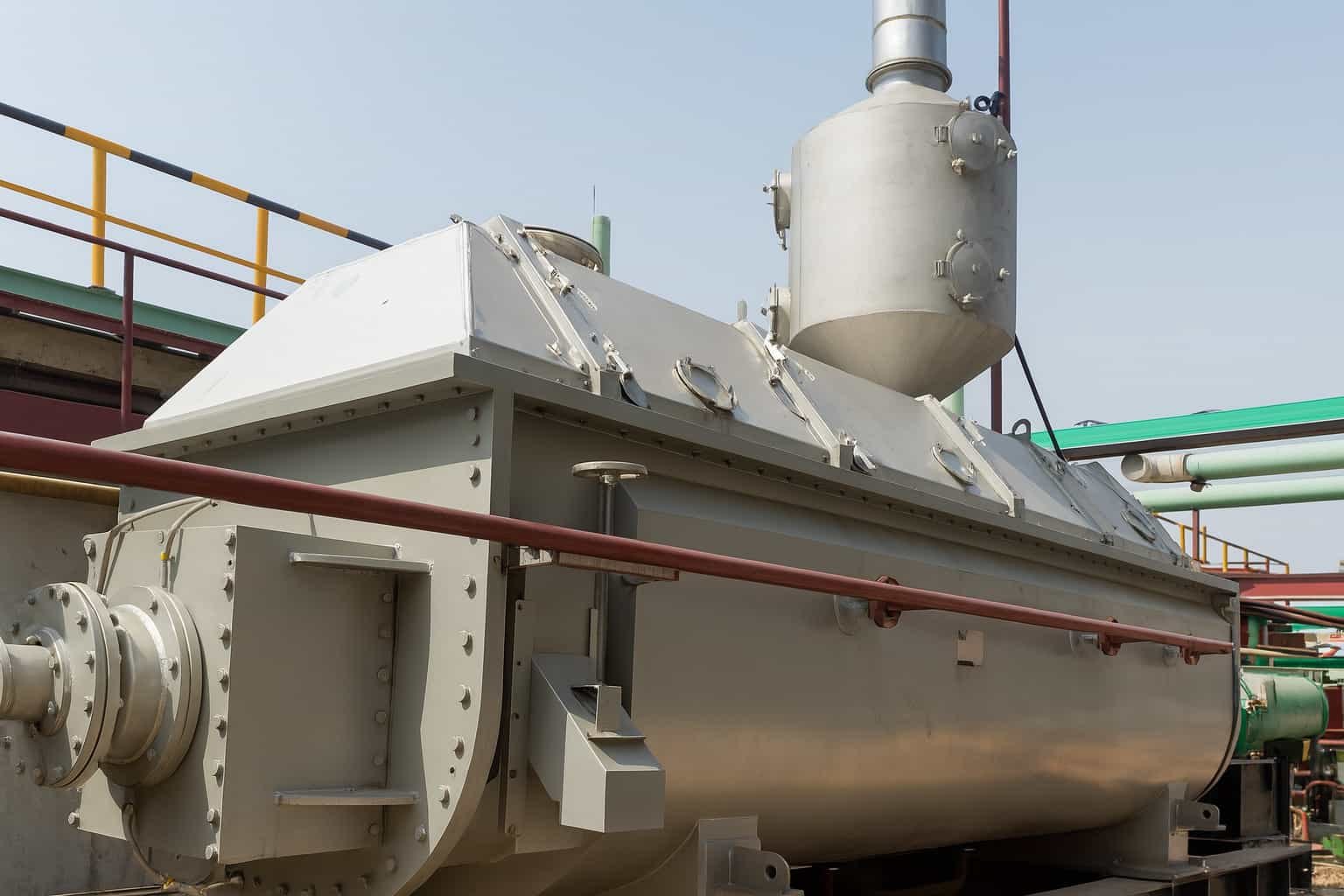
Indirect Heat Transfer
Indirect heat transfer is very important in how a paddle dryer works. The dryer has hollow paddles. These paddles have a heating medium inside. The heating medium can be steam or hot oil. Each one helps the process in a different way:
Steam heats the paddles well at medium temperatures.
Hot oil lets the dryer work at higher temperatures for special jobs.
Heat moves from inside the paddles to their surface. Then, it goes into the material. The heating medium never touches the product. The material does not touch the steam or oil. This keeps sensitive materials safe and stops bad reactions. Indirect heating also stops sticky problems that happen in other dryers.
Operators can control the temperature very closely. The dryer gives steady heat to the whole bed. This control keeps the product safe and makes sure it dries evenly. The indirect method also keeps the process clean. This is important for food, chemicals, and medicine.
Note: Indirect heat transfer in paddle dryers lowers the chance of contamination and keeps the process steady for sensitive materials.
Mechanical Agitation
Mechanical agitation mixes and moves the material inside the dryer. The system uses two shafts that spin in opposite ways. These shafts have wedge-shaped paddles. The paddles move through the bed and scrape the hot surfaces. This stops material from building up and keeps the bed clean.
The paddles mix the material strongly. They move it in different directions. This mixing makes sure all parts get heat. The flow inside the dryer keeps moisture even. Operators see almost no change in moisture from one spot to another.
The self-cleaning design works well with sticky or thick materials. Even if the material is very thick, the paddles keep it moving and stop sticking. The mixing and scraping keep heat transfer steady and help drying work well.
Mixing all the time keeps the bed the same.
Scraping stops buildup and keeps things moving.
The paddles help move material through the dryer.
Process Steps
The paddle dryer follows clear steps to dry materials. Each step uses careful control of flow, mixing, and bed movement:
Feeding: Operators put wet material into the dryer. The material spreads out on the bed.
Heating: The heating medium (steam or oil) goes into the paddles. Heat moves through the paddles into the bed.
Mixing: The paddles turn and mix the material. This mixing keeps the bed even and stops clumps.
Drying: As the process goes on, moisture leaves the material. The mixing and flow move the material through the bed so all parts get heat.
Discharge: When the material is dry enough, the system moves it out. The bed stays clean for the next batch.
Operators can change the process for different materials. The mixing, flow, and bed movement work together for even results. The dryer can handle many products, from sticky pastes to fine powders. The process helps move and dry materials well, so it is a good choice for many jobs.
💡 Tip: Careful control of mixing and flow in the bed gives better product quality and higher efficiency.
What Are the Advantages of paddle dryer?
Paddle dryers offer efficient, uniform drying with low energy consumption, making them ideal for thermal processing. They are particularly advantageous for handling heat-sensitive materials and provide a compact design that saves space.
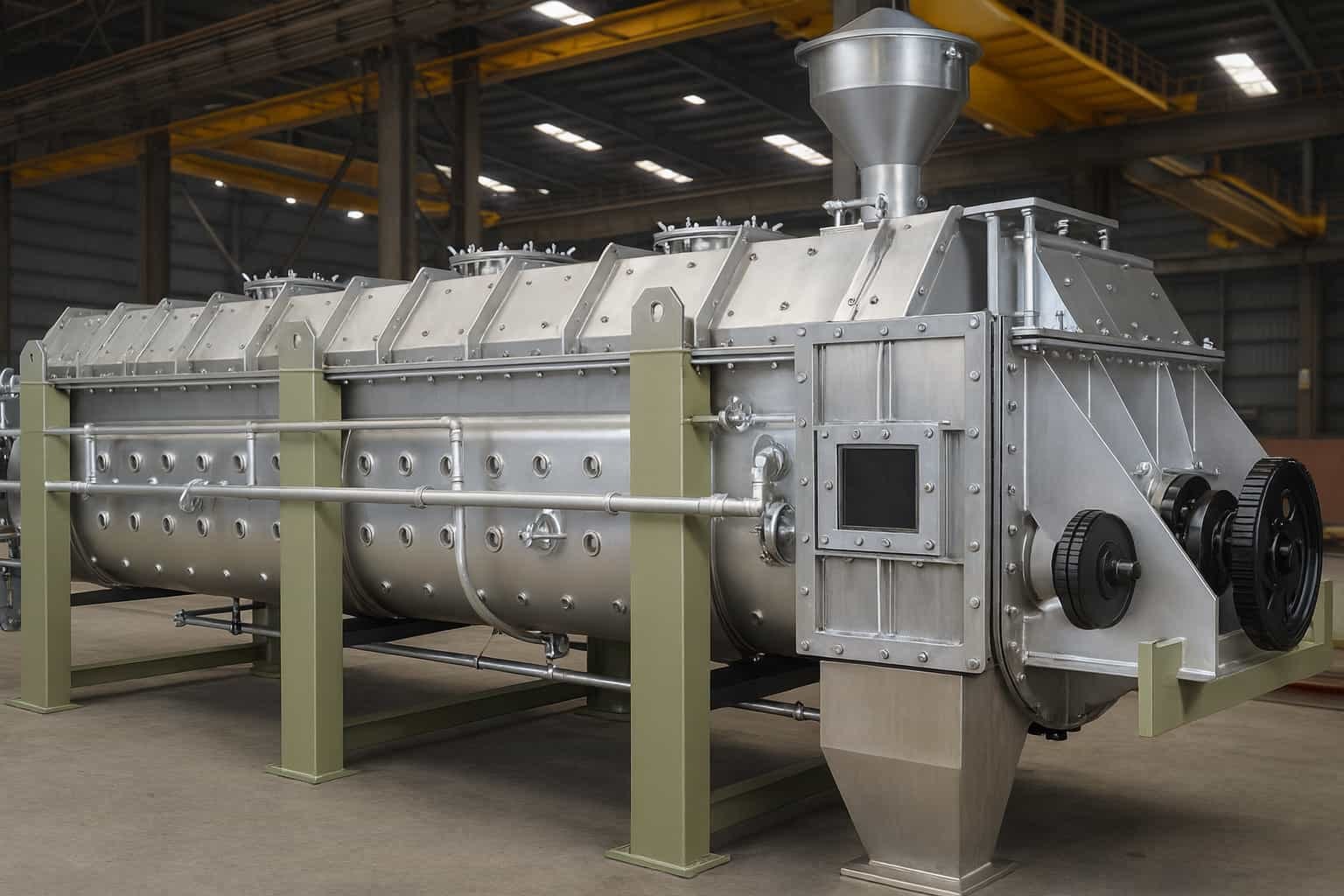
Precise Control
Paddle dryers let workers control heat, mixing speed, and drying time. This helps every batch dry the same way. The system lets people set the right settings for each material. Workers can change things for products that are hard to dry. This makes sure results stay the same and stops overheating or not drying enough.
Energy Efficiency
Paddle dryers use less energy than many old dryers. Their design uses heat that does not touch the product and keeps mixing it. This helps heat move better and saves power. The table below shows how much energy different paddle dryers use:
Paddle Dryer Model | Energy Consumption (kWh/t) | Drying Efficiency (%) | Typical Application |
|---|---|---|---|
Model A | 150 | 90 | Food Processing |
Model B | 120 | 92 | Pharmaceuticals |
Model C | 180 | 88 | Chemicals |
Model D | 160 | 91 | Waste Management |
Paddle dryers use between 120 and 180 kWh for each ton. This can save up to 30% energy compared to old dryers. Better mixing and heat use help lower bills and make more products.
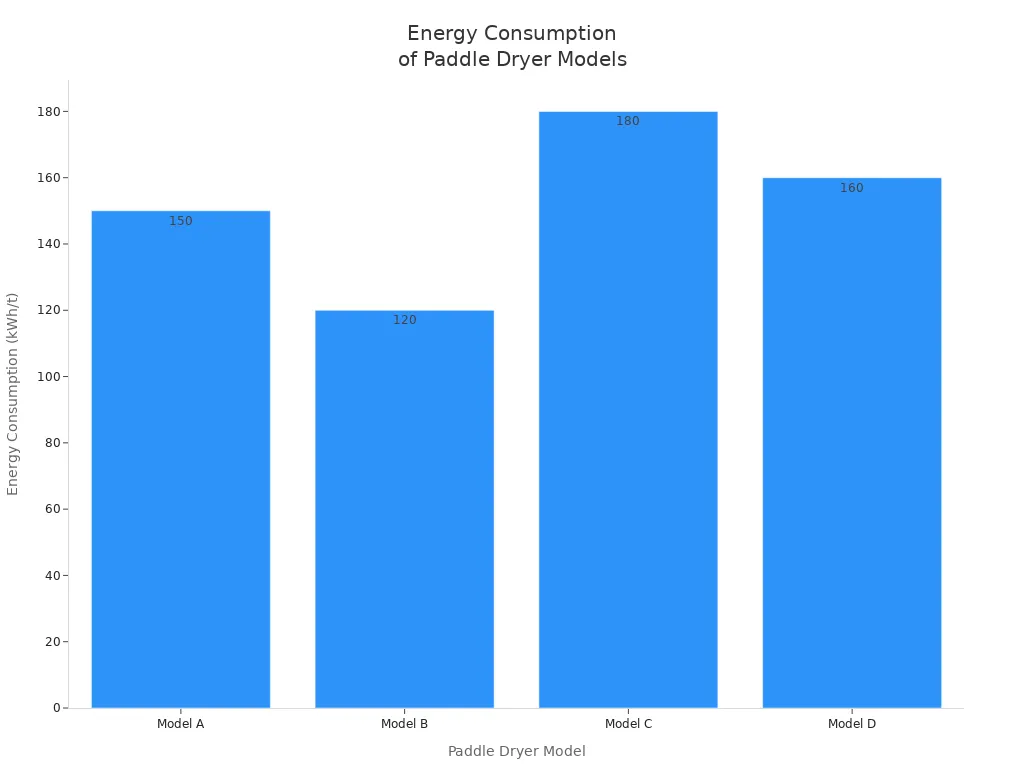
Material Care
Paddle dryers keep products safe while drying. The heat does not touch the material, so there are no hot spots. The paddles turn and mix gently, so the product does not get too hot. Workers can set the time, heat, and air for each batch. Vacuum helps with things that need low heat. The dryer is made from strong materials that do not rust. This keeps the product good and helps important industries.
Comparison with Other Dryers
Paddle dryers have some benefits over other dryers. The table below shows how they are different:
Aspect | Thin Film Dryer (Single Rotor) | |
|---|---|---|
Drying Principle | Indirect heating, thicker sludge layer | Indirect heating, thin film for efficient transfer |
Heat Transfer Efficiency | Lower, needs heated augers | Higher, thin film improves efficiency |
Maintenance Complexity | High, more components | Low, simple design |
Maintenance Space | High vertical space needed | Small vertical space |
Operational Advantages | Slow turning, energy efficient, small footprint | Quick startup, easy maintenance |
Product Quality Impact | May affect drying uniformity | Efficient transfer, easier operation |
Paddle dryers work well for sticky or gentle materials. Their design means less fixing and steady, good results.
Paddle dryers dry things evenly, save energy, and keep products safe. They work for many jobs and are a good choice for factories.
What Is an Indirect Batch Paddle Dryer?
An Indirect Batch Paddle Dryer is a type of industrial dryer used for drying, mixing, and reacting materials without direct contact with a heating medium. It operates in a batch process, meaning it handles a specific amount of material per cycle.
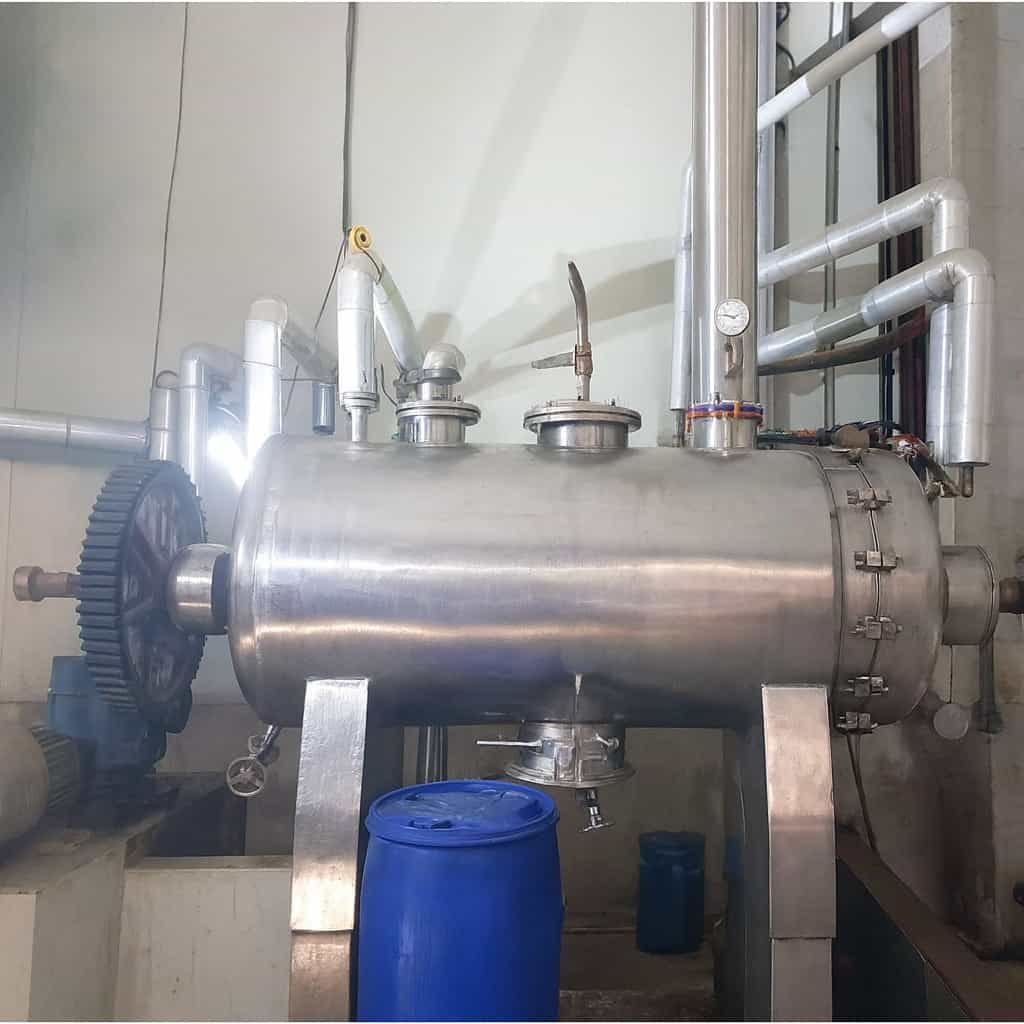
Batch vs. Continuous
Indirect batch paddle dryers dry a set amount at one time. They are good for small or medium jobs. Workers can change each batch for different needs. This helps when drying many types of materials. Continuous paddle dryers work without stopping. They are better for big factories that need to dry a lot. The table below shows how they are different:
Operational Aspect | Batch Paddle Dryer | Continuous Paddle Dryer |
|---|---|---|
Production Capacity | Processes fixed quantities per batch; suitable for small to medium scale production | Processes materials continuously; suitable for large-scale production with higher throughput |
Processing Time | Longer due to cyclic loading, drying, and unloading steps | Shorter due to continuous flow of material, enabling higher productivity |
Flexibility | High flexibility; can handle varying material types and properties | Less flexible; designed for specific materials and production rates |
Energy Efficiency | Less energy efficient; requires heating and cooling cycles | More energy efficient; maintains constant temperature and airflow |
Labor Requirements | Higher labor due to manual loading and unloading | Lower labor due to automation of material handling |
Cost | Lower initial cost but potentially higher operating costs due to labor and time | Higher initial cost but lower operating costs over time due to efficiency and automation |
With indirect batch paddle dryers, workers control each drying cycle. They can change the settings for every batch. This is helpful for gentle or special materials.
Customization Options
Manufacturers make indirect batch paddle dryers in many ways. Companies can pick the size and shape they want. They can choose how the paddles look and how the dryer heats up. Some dryers have special coatings for sticky or harsh products. Others have smart controls for heat and mixing speed. Some dryers are easy to clean or switch between products fast. These choices help every batch meet high quality rules. Workers can change the dryer to fit their job. This makes indirect batch paddle dryers useful for many kinds of work.
💡 Tip: Custom dryers can handle powders or pastes. They work well even if the product changes a lot.
Vacuum and Pressure Features
Indirect batch paddle dryers often use vacuum and pressure to dry better. These features help in many ways:
Vacuum lowers the boiling point, so drying needs less heat. This keeps gentle materials safe.
Special chambers and mixers spread heat evenly for good drying.
The mixer keeps things moving, so it uses less power and makes less dust.
Vacuum makes water leave faster and helps save solvents. This makes drying quick and keeps products good.
Closed vacuum systems stop germs and dirt from getting in. This is important for food, medicine, and chemicals.
Vacuum loading and unloading help with sticky or thick stuff.
Workers use these features for gentle and even drying. Indirect batch paddle dryers with vacuum and pressure controls help keep products safe and meet strict rules.
What Materials Are Compatible with This Equipment?
This equipment is compatible with a wide range of materials, including metals, plastics, ceramics, and composites. Each material type may require specific settings or adjustments for optimal performance.
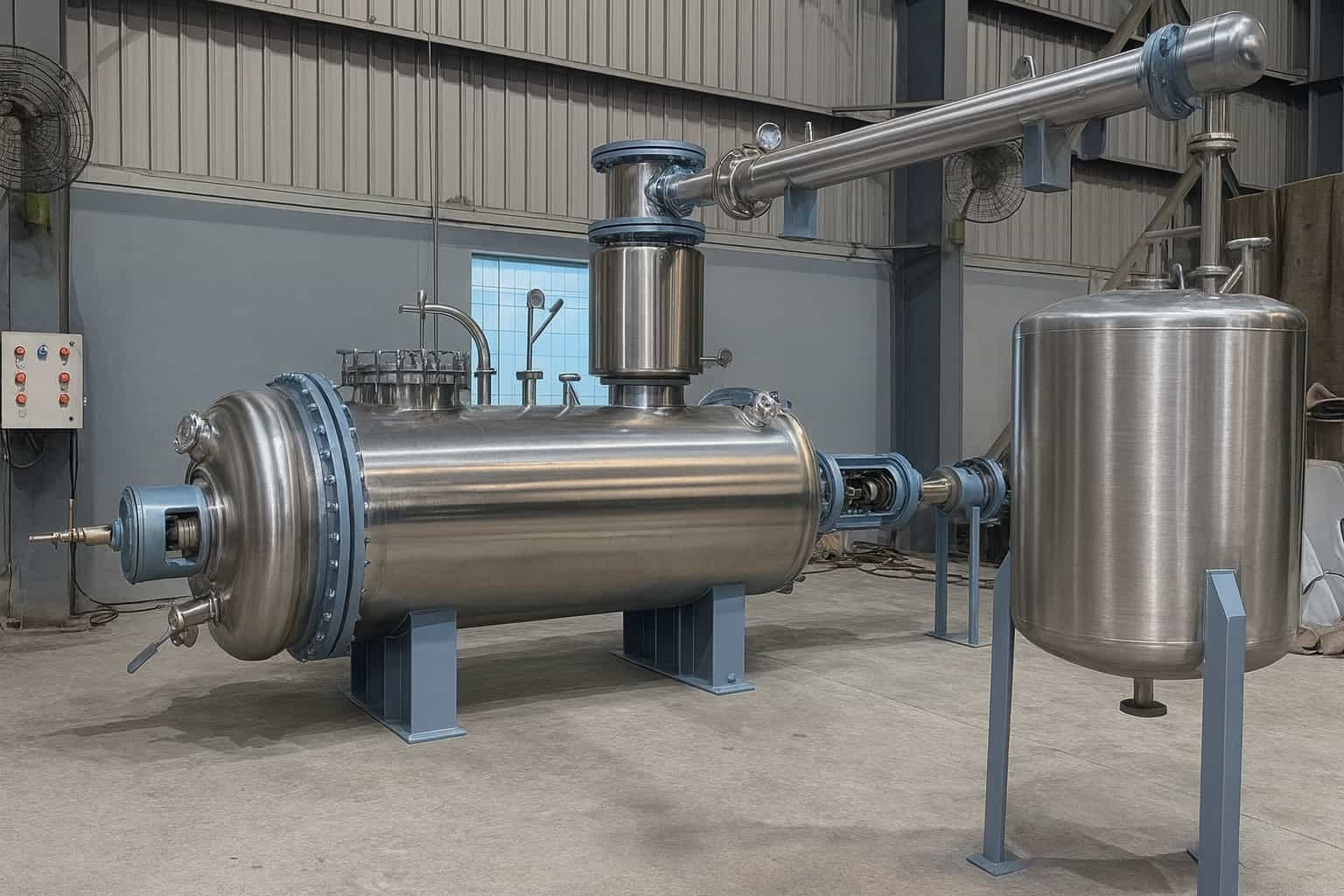
Sludge and Pastes
Paddle dryers work well with sludge and pastes. These materials are thick and sticky, so drying them is hard. The system mixes the material strongly to keep it moving. This stops lumps from forming and keeps the flow steady. Operators notice the bed stays even, which helps everything dry the same.
Sludge Moisture Content Phase | Challenge in Paddle Drying | Solution |
|---|---|---|
Sludge acts like a paste and is hard to move | Agitation keeps the flow and stops lumps | |
40-50% dry solids (sticky phase) | Sticky lumps form and cause problems | Mix wet sludge with dry granules to improve flow |
Above 70% dry solids | Material turns into granules or powder | Continue drying for easy granular flow |
The dryer is made to be safe. Using inert gas can stop dust explosions when the material gets dry and turns to granules. The system’s mixing and flow controls help workers handle each step, from sticky paste to free-flowing granules.
Powders and Granulates
Paddle dryers are good for powders and granulates. The paddles lift and mix the material to keep it spread out. This design helps the material flow and stops clumps. Operators can change the mixing speed for each product.
Mixing all the time keeps the heat even and stops hot spots.
The system dries things fast and does not take long.
Gentle mixing keeps the material safe from harm.
The sealed design keeps dust inside and makes it safer.
Operators can control how the material moves for better quality.
The dryer can handle granular flow, so it is great for jobs that need careful control. Its energy-saving and safety features help lower costs and risks.
Sensitive and Hazardous Materials
Many companies use paddle dryers for sensitive and dangerous materials. Indirect heating keeps the product safe from getting dirty. The sealed bed and controlled flow protect workers and the environment. Operators can use vacuum drying at low heat to stop damage from heat.
Feature/Criteria | Details |
|---|---|
Compatible Materials | APIs, intermediates, agrochemicals, specialty chemicals, food and nutraceutical powders |
Drying Conditions | Vacuum drying at low temperatures for heat-sensitive products |
Advantages | – Prevents thermal degradation |
Construction Materials | Stainless steel, glass-lined steel, Hastelloy for harsh environments |
Pharma-grade Features | Easy cleaning and sterilization (CIP/SIP) |
Operators pick paddle dryers for these jobs because they can control mixing, flow, and bed spread very well. The design meets strict safety and quality rules, so it works for making medicine and chemicals.
Tip: Testing in a small dryer first helps find the best settings for each material and makes sure it works well before using a big dryer.
Paddle dryers help many factories because they are easy to set up, use less power, and need fewer workers. Their small size, soft way of moving things, and safety parts make them good for materials that need extra care.
Indirect batch paddle dryers let workers control drying well, give steady heat, and work with lots of products.
Benefit | Explanation |
|---|---|
Precision | Workers can set drying steps very closely |
Material Protection | Gentle mixing keeps the material from getting ruined |
Scalability | Can be changed to fit many kinds of jobs |
To pick the best dryer, companies should look at what the material is like, how much they need to dry, how much energy it uses, and how much room they have. Talking to good sellers and trying out small amounts first helps make sure the dryer is right for the job.
FAQ
What materials can a paddle dryer handle?
A paddle dryer can dry sludge, pastes, powders, and granules. It also works with sensitive chemicals. Many companies use it for food, medicine, and waste jobs. The machine is good for sticky or heat-sensitive things. It can also handle dangerous materials.
How does a paddle dryer prevent contamination?
The sealed design keeps the product safe from germs. Indirect heating means the material does not touch the heat source. The system uses vacuum or inert gas to block outside air. This setup protects food, medicine, and chemicals from dust and germs.
What maintenance does a paddle dryer require?
Workers need to check seals, paddles, and shafts often. They should clean the vessel and look at the drive system. This helps stop problems before they start. Many models are easy to open for cleaning and fixing.
Can a paddle dryer recover solvents during drying?
Feature | Benefit |
|---|---|
Closed system | Captures solvents |
Vacuum option | Improves recovery rates |
A paddle dryer can collect solvents while drying. The closed system and vacuum help save valuable vapors during the process.

